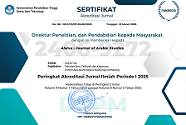Mushkilāt al-Ṭalabah fī Qirā’at al-Nuṣūṣ al-ʿArabīyah ʿalá Asās Naẓarīyat Muḥammad ʿAlī al-Khūlī
DOI:
https://doi.org/10.21580/alsina.4.2.13706Keywords:
Arabic text, Muhammad Ali Al-Khuli, reading problems, reading skillsAbstract
This study aims to describe the problems that students face when reading Arabic texts based on Muhammad Ali Al Khuli's theories. The qualitative descriptive field method was used in this study. Data collection methods included: (1) observation, (2) questionnaire, and (3) interview methods. Data analysis methods in this study were based on Miles and Huberman's methods, which involve 4 steps: (1) data collection, (2) data reduction, (3) data presentation, and (4) data conclusion. Meanwhile, data validity testing in this study used triangulation methods from both data sources and data collection. The results of this study showed that the problems faced by students in reading Arabic texts include moving backward, emplacement, focusing, confusion, preparation, boredom, remembering, taking notice, attention, and repetition problems.
Downloads
References
Akrom, Muhamad Diyaul. Mushkilāt Mahārat al-Qirā’ah fī Taʿlīm al-Lughah al-ʿArabīyah fī al-Madrasah al-Mutawassiṭah “Al-Mubarok” Margolinduk bi-Demak fī al-Sanah al-Dirāsīyah 2020/2021 (Undergraduate Thesis). Kudus: IAIN Kudus, 2021. http://repository.iainkudus.ac.id/5911/.
Al-Fawzān, ʿAbd al-Raḥmān bin Ibrāhīm. Iḍā’āt li-Muʿallimī al-Lughah al-ʿArabīyah li-Ghayr al-Nāṭiqīn bi-Hā. Riyadh: Fahrasat Maktabat al-Malik Fahd al-Waṭanīyah Athnā’ al-Nashr, 2011.
Al-Ḥadīdī, ʿAlī. Mushkilat Taʿlīm al-Lughah al-ʿArabīyah li-Ghayr al-ʿArab. Cairo: Dār al-Kātib al-ʿArabī, 1966.
Al-Huri, Ibrahim. “Arabic Language: Historic and Sociolinguistic Characteristics.” English Literature and Language Review 1, no. 4 (2015): 28–36. https://arpgweb.com/journal/9/archive/07-2015/4/1.
Al-Khūlī, Muḥammad ʻAlī. Al-Mahārāt al-Dirāsīyah. Amman: Dār al-Falāḥ lil-Nashr wa-al-Tawzīʻ, 2006.
Al-Shanṭī, Muḥammad Ṣāliḥ. Al-Mahārāt al-Lughawīyah: Madkhal ilá Khaṣāʼiṣ al-Lughah al-ʻArabīyah wa-Fununihā. Haʼil: Dār al-Andalus lil-Nashr wa-al-Tawzīʻ, 1996.
Alfarochi, Ahmad Zulfahmi. Mushkilāt Taʿlīm Mahārat al-Qirā’ah fī al-Lughah al-ʿArabīyah li-Ṭullāb al-Ṣaff al-Sābiʿ bi-al-Madrasah al-Thānawīyah al-Islāmīyah al-Ḥukūmīyah al-Ūlá Yogyakarta al-ʿĀm al-Dirāsah 2014/2015 (Undergraduate Thesis). Yogyakarta: UIN Sunan Kalijaga Yogyakarta, 2015. https://digilib.uin-suka.ac.id/id/eprint/18502/.
Elizabeth, M.E.S. Methods of Teaching English. New Delhi: Discovery Publishing House, 2017.
Hasyim, Mohamad Yusuf Ahmad. “The Effectiveness of Problem-Based Learning on Advanced Reading Comprehension Skill in Online Arabic Language Teaching.” LISANIA: Journal of Arabic Education and Literature 5, no. 1 (2021): 1–18. https://doi.org/10.18326/lisania.v5i1.1-18.
Hermawan, Acep. Metodologi Pembelajaran Bahasa Arab. Bandung: PT. Remaja Rosdakarya, 2014.
Ibrāhīm, ʿAbd al-ʿAlīm. Al-Muwajjah Al-Fannī Li-Mudarrisī Al-Lughah Al-ʿArabīyah. Cairo: Dār al-Maʿārif, 2008.
J, Hafees S. “Recognising the Problems of Arabic Learning Students: Issues in Identifying the Letters or Words.” Education Times 6, no. 1 (2017): 251–57.
Khāṭir, Maḥmūd Rushdī, Yūsuf Ḥammādī, Muḥammad ʻIzzat ʻAbd Al-Mawjūd, Rushdī Aḥmad Ṭuʿaymah, and Ḥasan Shiḥātah. Ṭuruq Tadrīs al-Lughah al-ʻarabīyah wa-al-Tarbiyah al-Dīnīyah fī Ḍawʼ al-Ittijāhāt al-Tarbawīyah al-Ḥadīthah. Kuwait: Mu’assasat al-Kutub al-Jāmiʿīyah, 1998.
Khikmah, Nur. “Problematika Membaca Teks Arab bagi Siswa Madrasah.” Alsina : Journal of Arabic Studies 1, no. 1 (2019): 47–66. https://doi.org/10.21580/alsina.1.1.3666.
Li, Zhijiao. “Implementation Strategies for Improving the Teaching Quality of Foreign Language Courses.” International Journal of Emerging Technologies in Learning (iJET) 15, no. 24 (2020): 128–44. https://doi.org/10.3991/ijet.v15i24.19031.
Madkūr, ʻAlī Aḥmad. Tadrīs Funūn Al-Lughah Al-ʻArabīyah. Cairo: Dār al-Fikr al-ʻArabī, 2008.
Miles, Matthew B., A. Michael Huberman, and Johnny Saldana. Qualitative Data Analysis: A Methods Sourcebook. 3rd ed. California: SAGE Publications, Inc, 2014.
Nur Sofiana, Arina, Nur Hapsari, and Nurul Huda. “The Problems of Reading Arabic Text in Terms of Phonological Aspects (Case Study in Fifth Grade Students of SD Qurrota A’yun Babadan Bantul DIY Academic Year 2020/2021).” Al Mahāra: Jurnal Pendidikan Bahasa Arab 7, no. 1 (2021): 138–62. https://doi.org/10.14421/ALMAHARA.2021.071-08.
Rokib, Ahmad. Mushkilāt Taʿlīm al-Lughah al-ʿArabīyah fī Mahārat al-Qirā’ah ladá al-Ṭullāb al-Faṣl al-Sābiʿ al-Madrasah al-Mutawassiṭah al-Islāmīyah As-Sidah Kudus al-’Āmm al-Dirāsī 2020/2021 (Undergraduate Thesis). Kudus: IAIN Kudus, 2021. http://repository.iainkudus.ac.id/5995/.
Suryani, Wilda, and Abdul Sattar Daulay. “Mushkilāt Taʿlīm Qirā’at al-Kutub li-Ṭalabat Qism Tadrīs al-Lughah al-ʿArabīyah.” Thariqah Ilmiah: Jurnal ilmu-ilmu kependidikan dan Bahasa Arab 7, no. 1 (2019): 1–17. https://doi.org/10.24952/thariqahilmiah.v7i01.1865.
Tim Penyusun Kamus Pusat Bahasa. Kamus Besar Bahasa Indonesia. Jakarta: Pusat Bahasa, 2018.
Yūnus, Fatḥī ʿAlī, Maḥmūd Kāmil Al-Nāqah, and ʻAlī Aḥmad Madkūr. Asāsīyāt Taʻlīm al-Lughah al-ʻArabīyah wa-al-Tarbiyah al-Dīnīyah. Cairo: Dār al-Thaqāfah lil-Ṭibāʻah wa-al-Nashr, 1977.
Zulhannan. Teknik Pembelajaran Bahasa Arab Interaktif. Jakarta: PT. Raja Grafindo Persada, 2014.
Downloads
Published
How to Cite
Issue
Section
License
Copyright
The copyright of the received article shall be assigned to the publisher of the journal. The intended copyright includes the right to publish the article in various forms (including reprints). The journal maintains the publishing rights to published articles. Authors are allowed to use their articles for any legal purposes deemed necessary without written permission from the journal, but with an acknowledgment to this journal of initial publication.
Licensing
In order for Alsina: Journal of Arabic Studies to publish and distribute research articles, the editors need publishing rights (transferred from author to publisher). This agreement relates to the transfer/publishing copyright license to Alsina: Journal of Arabic Studies but the authors still have significant rights to use and share their published articles.
Alsina: Journal of Arabic Studies supports the need for writers to share, disseminate and maximize the impact of their research and their rights on any database. As a journal article writer, you have the right to various uses of your articles, including that by the institution or company where you work. Copyright can be used without the need for special permission. Authors who publish articles in the Alsina: Journal of Arabic Studies have broad rights to use their work for teaching and scientific purposes without requesting permission, including:
- Use by the author for lectures, presentations, or conferences, with distribution of copies to participants;
- Distribution to colleagues for research use;
- Use in compilations of the author's subsequent work;
- inclusion in a thesis or dissertation;
- Reuse of sections or excerpts from articles in other works (with full acknowledgment of the final article);
- Preparation of derivative works (other than commercial purposes) (with full acknowledgment of the final article);
- Voluntary posting on open websites operated by authors’ or writers' agencies for scientific purposes
When submitting a manuscript, authors do so on the understanding that if accepted for publication, the copyright for publishing (publishing right) of the article shall be assigned/transferred to Alsina: Journal of Arabic Studies.
Authors whose articles are accepted for publication will receive confirmation via email and sent a Copyright Transfer Agreement.


 Accreditation
Accreditation 
 In Collaboration with
In Collaboration with 

 Visitors
Visitors  Article Template
Article Template





